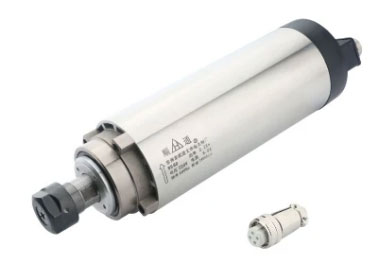Home / News / Air Bearing Spindle: Principles, Advantages, and Applications
Air Bearing Spindle: Principles, Advantages, and Applications
Introduction
Air bearing spindles are a type of spindle technology that utilizes a thin film of pressurized air to support the spindle shaft, eliminating the need for traditional mechanical bearings. These spindles offer numerous advantages over conventional spindle systems, such as reduced friction, increased precision, and minimal maintenance requirements. This article will discuss the principles of air bearing spindles, their advantages, and various applications in advanced machinery and industries.

Principles of Air Bearing Spindles
Air bearing spindles operate based on the principle of hydrodynamic or aerostatic lubrication. In hydrodynamic bearings, the air pressure is generated by the spindle's rotation, while in aerostatic bearings, an external source of pressurized air is supplied to create the air film.
The pressurized air forms a thin film between the spindle shaft and the bearing surfaces, allowing the spindle to "float" on the air cushion. This eliminates direct contact between the spindle and the bearing surfaces, resulting in minimal friction and wear.
Advantages of Air Bearing Spindles
Reduced Friction and Wear
The absence of mechanical contact between the spindle shaft and bearing surfaces in air bearing spindles results in significantly reduced friction and wear. This leads to smoother operation, extended service life, and reduced maintenance costs.
High Speed and Precision
Air bearing spindles can achieve higher rotational speeds compared to traditional spindle systems due to the minimal friction and heat generation. Additionally, the absence of mechanical contact ensures excellent axial and radial stiffness, resulting in higher precision and accuracy.
Minimal Maintenance Requirements
Since there is no mechanical contact and minimal wear in air bearing spindles, the need for regular maintenance, such as lubrication and bearing replacement, is significantly reduced. This results in lower operating costs and minimized downtime.
Clean Operation
Air bearing spindles are virtually contamination-free, as there is no need for lubricants, and the pressurized air film helps prevent the ingress of dust and debris. This makes them particularly suitable for applications in cleanroom environments or where contamination-sensitive processes are involved.
Applications of Air Bearing Spindles
Air bearing spindles are utilized in various industries and advanced machinery, including:
Semiconductor Manufacturing
The high precision, cleanliness, and minimal maintenance requirements of air bearing spindles make them ideal for use in semiconductor manufacturing equipment, such as photolithography and wafer inspection systems.
Metrology and Inspection
Air bearing spindles are used in precision measurement and inspection equipment, such as coordinate measuring machines (CMMs), profilometers, and roundness testers, where high accuracy and repeatability are essential.
High-Speed Machining
The ability of air bearing spindles to achieve high rotational speeds makes them suitable for high-speed machining applications, such as micro-milling, engraving, and ultra-precision grinding.
Optical and Electronic Component Manufacturing
The high precision and clean operation of air bearing spindles make them suitable for the manufacture of sensitive optical and electronic components, such as lenses, mirrors, and microelectromechanical systems (MEMS).
Conclusion
Air bearing spindles offer numerous advantages over traditional spindle systems, including reduced friction, increased precision, and minimal maintenance requirements. Their unique properties make them well-suited for a wide range of applications in advanced machinery and industries requiring high precision and cleanliness. As technology advances and the demand for higher precision and performance continues to grow, air bearing spindles are expected to play an increasingly significant role in the future of manufacturing and inspection processes.
- Previous: Spindle Bearing Noise: Causes, Diagnosis, and Remediation
- Next: Precision Spindle Bearings: Types, Features, and Applications













